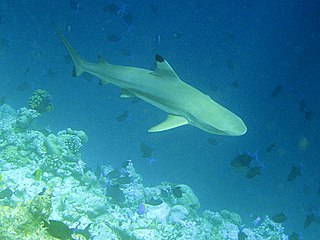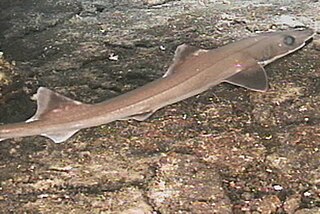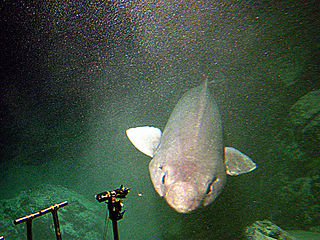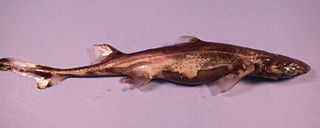
Requiem sharks are sharks of the family Carcharhinidae in the order Carcharhiniformes. They are migratory, live-bearing sharks of warm seas and include such species as the bull shark, lemon shark, blacktip shark, and whitetip reef shark.

Apristurus is a genus of catsharks, the family Pentanchidae, the deepwater catsharks. The species in this genus are commonly known as the ghost or demon catsharks.

The slender smooth-hound or gollumshark is a species of ground shark in the family Pseudotriakidae. It is endemic to the waters around New Zealand, where it is usually found close to the bottom over the continental slope at depths of 300–600 m (980–1,970 ft). An extremely slim, plain brownish shark reaching 1.1 m (3.6 ft) in length, the slender smooth-hound can be identified by its broad, flattened head with a long, distinctively bell-shaped snout. Its mouth is angular with short furrows at the corners, and contains a very high number of tooth rows in both jaws. Its two dorsal fins are roughly equal in size.

The false catshark or sofa shark is a species of ground shark in the family Pseudotriakidae, and the sole member of its genus. It has a worldwide distribution, and has most commonly been recorded close to the bottom over continental and insular slopes, at depths of 500–1,400 m (1,600–4,600 ft). Reaching 3.0 m (9.8 ft) in length, this heavy-bodied shark can be readily identified by its elongated, keel-like first dorsal fin. It has long, narrow eyes and a large mouth filled with numerous tiny teeth. It is usually dark brown in color, though a few are light gray.

Etmopterus is a genus of lantern sharks in the squaliform family Etmopteridae. They are found in deep sea ecosystems of the Atlantic, Indian and Pacific Oceans.

Gollum is a genus of ground sharks in the family Pseudotriakidae, native to the southwestern Pacific Ocean. The genus was described in 1973 by biologist Leonard Compagno, who named it named after the character Gollum from J. R. R. Tolkien's works, noting the species Gollum attenuatus "bears some resemblance in form and habits".
The black legskate is a species of smooth skate native to the Indian Ocean off of Madagascar and Mozambique. It is the only species in the monotypic genus Indobatis. It inhabits the continental slope at depths of from 1,000 to 1,725 metres. This species can reach a length of 21 centimetres (8.3 in). It is dark-colored, greyish-black or brownish on the dorsum, ventrally lighter.
Bythaelurus is a genus of sharks belonging to the family Pentanchidae, the deepwater catsharks. The genus Bythaelurus Compagno 1988 was first described as a subgenus of Halaelurus Gill 1862 based on several morphological characteristics including a soft body with thin skin, a bluntly rounded snout without a pointed, knob-like tip, and eyes not noticeably elevated on the dorsal surface of the head. Members of this genus are generally found in deep water and have more somber body coloration.

Leucoraja is a genus of hardnose skates in the family Rajidae, commonly known as the rough skates. They occur mostly on continental shelves and slopes in the north-western and eastern Atlantic Ocean, the Mediterranean Sea, the south-western Indian Ocean, and Australia.

Arhynchobatidae is a family of skates whose members are commonly known as the softnose skates. It belongs to the order Rajiformes in the superorder Batoidea of rays. At least 104 species have been described, in 13 genera. Softnose skates have at times been placed in the same family as hardnose skates, but most recent authors recognize them as a distinct family. Members of the Arhynchobatidae can be distinguished from hardnose skates in having a soft and flexible snout, as well as a more or less reduced rostrum.

Wedgefishes are rays of the family Rhinidae, comprising eleven species in three genera. Classified in the order Rhinopristiformes along with guitarfishes and sawfishes, they have also been known as giant guitarfishes or sharkfin guitarfishes.

Okamejei is a genus of small skates in the family Rajidae from the central and western Indo-Pacific, and the north-western Pacific Ocean.
The Sulu gollumshark is a species of ground shark in the family Pseudotriakidae, found off Palawan Island in the southern Philippines. This recently discovered species was discovered at a fish market in Palawan during a project led by the World Wildlife Fund during the 1990s to investigate elasmobranch biodiversity in the area.
The jaguar catshark, also known as the Galápagos catshark, is a species of shark belonging to the family Pentanchidae, the deepwater catsharks, endemic to the Galápagos Islands. The species was first described in 2012. This catshark is about 30 cm (12 in) long when mature, and it is colored blackish-brown with an asymmetrical pattern of light spots.
Planonasus is a genus of ground sharks in the family Pseudotriakidae, native to the western Indian Ocean.
The dwarf false catshark is a species of ground shark, which lives in the Indian Ocean near Socotra. This species is one of two known members of its genus, the other being the pygmy false catshark off the coast of India, Sri Lanka, and the Maldives. The pygmy false catshark is very closely related to the dwarf false catshark, but has some morphological differences. Two examples are its absence of an oral papillae and that it has more tooth rows in the lower jaw.
Sinobatis is a genus of rays in the family Anacanthobatidae native to deep water in the Indo-Pacific Ocean.
The pygmy false catshark, also known as the eastern dwarf false catshark is a species of ground shark, which lives in the Indian Ocean near Kochi, Kerala and off Sri Lanka. This species is one of two known members of its genus, the other being the dwarf false catshark which also lives in the Indian Ocean, but near Socotra. This had prior been an uncategorized species, but was recognized as a new species in 2019.











